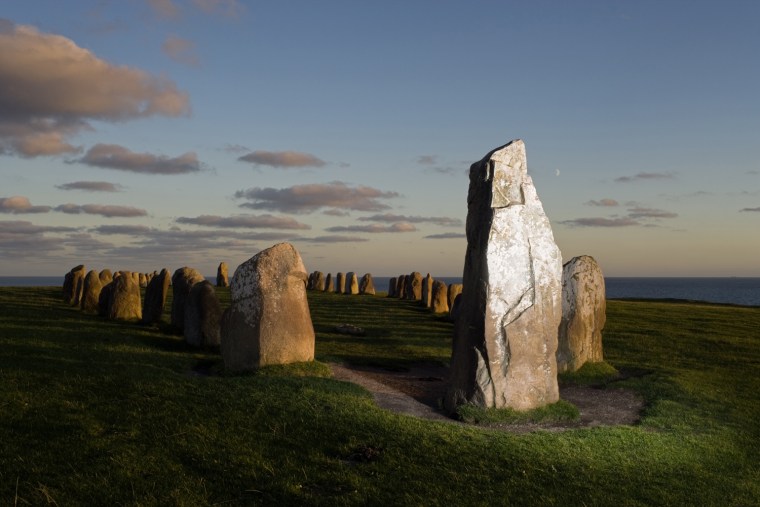Ancient Scandinavians dragged 59 boulders to a seaside cliff near what is now the Swedish fishing village of Kaseberga. They carefully arranged the massive stones — each weighing up to 4,000 pounds (1,800 kilograms) — in the outline of a 220-foot-long (67-meter) ship overlooking the Baltic Sea.
Archaeologists generally agree this megalithic structure, known as Ales Stenar ("Ale's Stones"), was assembled about 1,000 years ago, near the end of the Iron Age, as a burial monument. But a team of researchers now argues it's really 2,500 years old, dating from the Scandinavian Bronze Age, and was built as an astronomical calendar with the same underlying geometry as England's Stonehenge.
"We can now say Stonehenge has a younger sister, but she's so much more beautiful," said Nils-Axel Morner, a retired geologist from Stockholm University who co-authored the paper on the interpretation, published in March in the International Journal of Astronomy and Astrophysics.
Other researchers familiar with the site are skeptical. Among other arguments, they cite the results of carbon dating to reject Morner's interpretation.
Inspired by Stonehenge?
Morner says his team observed that the sun rises and sets at specific points around Ales Stenar at the summer and winter solstices, hinting that an ancient culture could have built it as an astronomical calendar to time things like annual religious ceremonies or planting and harvesting crops. [ Stunning Photos of Summer Solstice ]
They also observed that certain aspects of the stone ship's geometry matched those of Stonehenge, a Bronze Age monument that some enthusiasts believe was used as a calendar. (Those claims are contentious, and there are many other theories of Stonehenge's original purpose.)
The similarities led Morner to propose that the mysterious stone structure of Sweden was a Stonehenge-inspired astronomical calendar constructed by a Bronze Age Scandinavian community that regularly traveled and traded throughout Europe and the Mediterranean.
"The first thing is to see that, yes, it's a calendar," Morner told LiveScience. "But Ale's Stones also tells us a lot more than we knew before about trading and travel in the Bronze Age among Scandinavia, England and Greece."
Beowulf, not the Bronze Age
Other researchers are not convinced.
"The idea that the stone ship might have been an astronomical calendar has no supporters among academic archaeologists," said Swedish archaeologist Martin Rundkvist, managing editor of the archaeology journal Fornvannen.
Rather, Ales Stenar was probably an ornate grave marker, he said.
The Swedish countryside is home to many similar megalithic structures, which are generally known as stone ships. Most of them date back to Sweden's Late Iron Age (about A.D. 500-1000), and they serve as burial monuments, Rundkvist said.
Archaeologists using radiocarbon dating have calculated that Ales Stenar was built about 1,400 years ago, near the end of Scandinavia's Iron Age — long after the construction date estimated by Morner's team. [ Photos: Mysterious Stone Structures ]
Ales Stenar was built by members of a warlike community of seafarers who used oxen, slaves, rope, sleds, wooden spades and simple steel tools to collect and raise the huge boulders, Rundkvist said.
"This was the world of Beowulf," Rundkvist said, referring to the epic poem set in Iron Age Scandinavia.
Ships were an important part of life in this nautical culture, which may have inspired communities to mark the graves of important people with stone ships, some scholars say.
Rundkvist believes there's no evidence for anything beyond that — including Morner's Stonehenge theory.
"New Age mystics like standing stones," Rundkvist told LiveScience.
Follow LiveScience for the latest in science news and discoveries on Twitter @livescience and on .
